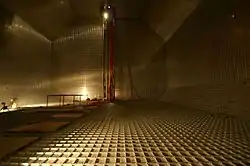Gaztransport & Technigaz
Gaztransport & Technigaz SA is a French multinational naval engineering company with headquarters in Saint-Rémy-lès-Chevreuse, France.
 | |
| GTT | |
| Type | Société Anonyme |
| Euronext: GTT CAC Mid 60 Component | |
| ISIN | FR0011726835 |
| Industry | Engineering |
| Founded | Gaztransport January 1966, 10 [1] |
| Headquarters | Saint-Rémy-lès-Chevreuse, |
Area served | Worldwide |
Key people | Philippe Berterottière Chairman & Chief Executive Officer |
| Services |
|
| Revenue | |
Number of employees | 342 [2] (2018) |
| Subsidiaries |
|
| Website | gtt.fr |
Trading as the GTT Group, the company is an engineering organization specializing in membrane containment systems dedicated to the transport and storage of liquefied gas worldwide. GTT has developed and patented multiple solutions for the liquefied gas industry, in particular for Liquefied Natural Gas (LNG).[3]
The current company was established through a merger between rival companies Gaztransport SA and Technigaz SA in 1994.[4]
On the 27 February 2014 the GTT Group was listed on the Euronext Paris stock exchange.[5]
History
In the 1950s, European companies were looking for solutions to transport Algerian gas from the Sahara to Europe. The idea of a North African pipeline was scrapped due to regional instability at the time and this led to the first boom in the shipping of gas by sea in the form of a cryogenic liquid in LNG carriers.
After the Evian Accords in 1962, France purchased its first LNG carrier - the Jules Verne - for operation on the route between Oran and France. Great Britain already had two of these vessels at this time.[4]
Both Gaztransport and Technigaz emerged as a result of the innovations taking place in this historical context.
Technigaz
In 1963 Gazocean, a company jointly owned by Gaz de France and NYK Line, created a subsidiary called Technigaz responsible for developing new LNG transportation technology.[4] In 1964 Technigaz filed for a patent for "wallpanels for so-called membrane tanks" which was granted in 1968[6] and which led to the development of the Mark I containment system. Between 1968 and 1979, twelve LNG carriers were built using Technigaz Mark technology.[4]
In 1983 Technigaz was sold to the Amrep Group[4] which subsequently went bankrupt in 1984 and was itself taken over by the Bouygues Group.[7] In 1994 Technigaz was merged with Gaztransport to create Gaztransport & Technigaz.[8]
Gaztransport
Gaztransport was founded on the 10 January 1966.[1] In 1967 Phillips Petroleum and Marathon Oil, which held contracts to import gas into Japan, placed an order for two LNG carriers, Polar Alaska and Arctic Tokyo, that were built in the Swedish shipyard of Kockums. These ships remained in operation for 45 years.[4] In 1969 the Polar Alaska was launched, and between 1969 and 1978, ten LNG carriers used the NO systems developed by Gaztransport.[4]
In 1994 Gaztransport was merged with Technigaz and Technigaz Shipping to create Gaztransport & Technigaz.[8]
Company
Shareholders
As of April 2019, the Shareholders were:[9]
| Shareholder | Shareholding |
|---|---|
| ENGIE SA | 40.4% |
| Norges Bank Investment Management | 2.12% |
| Henderson Global Investors Ltd. | 1.88% |
| The Vanguard Group | 1.59% |
| JPMorgan Asset Management (UK) Ltd. | 1.53% |
| Mandarine Gestion SA | 1.42% |
| BFT Investment Managers SA | 0.96% |
| Mellon Investments Corp. | 0.87% |
| Rouvier Associés SAS | 0.81% |
| Argenta Banque d'Epargne SA | 0.72% |
Subsidiaries
As of April 2019, the Subsidiaries were:[3]
| Subsidiary | Ownership |
|---|---|
| GTT North America | 100% |
| Cryovision | 100% |
| GTT Training | 100% |
| GTT SEA PTE | 100% |
| Cryometrics | 100% |
| Ascenz | 75% |
Technologies

In order to store and transport Liquefied Natural Gas (LNG) an envelope or membrane system is required to separate the liquid gas at -163 °C from the ship's hull and to reduce evaporation.
GTT inherited the Mark and NO technologies from its founding companies and has since developed these technologies to their current forms.[10]
- The Mark III systems use a membrane based cryogenic liner composed of a primary metallic membrane positioned on top of a prefabricated insulation panel including a complete secondary membrane. The membranes are directly supported by the ship’s inner hull.
- The NO96 systems are also composed of a membrane system that is a cryogenic liner directly supported by the ship’s inner hull. This liner includes two identical metallic membranes and two independent insulation layers.
- The NO96 Max systems offer a compromise between low boil-off and system strength, for better thermomechanical efficiency.
In addition, GTT has developed a new technology specifically for the transportation of Liquefied Petroleum Gas (LPG) called GTT MARS.[11]
In April 2019 the National Institute of Industrial Property ranked GTT fourth in its leading companies list with 19 patents filed.[12]
Singapore hub
In April 2019 GTT announced that it would be creating a "digital hub of excellence" in Singapore.[13]
References
- "Societe Company Profile". Retrieved 8 April 2019.
- "Investor Presentation" (PDF). GTT. Retrieved 8 April 2019.
- "Registration Document 2017" (PDF). GTT. Retrieved 8 April 2019.
- "GTT History". GTT. Retrieved 8 April 2019.
- "Euronext IPO detail". Euronext. Retrieved 8 April 2019.
- "Patent Record 1964". Google. USPTO. Retrieved 8 April 2019.
- Barjot, Dominique. "BOUYGUES, 1952-1989". European Business History Association. EBHA. Retrieved 8 April 2019.
- "GTT Merger". LNG Industry. Retrieved 8 April 2019.
- "Marketscreener". MarketScreener. Retrieved 23 April 2019.
- "Technologies". GTT. Retrieved 23 April 2019.
- "GTTMARS". GTT. Retrieved 26 May 2019.
- "GTT ranked 4th". Maritime Shipping News. Maritime Shipping News. Retrieved 26 May 2019.
- "Hub of Excellence". GTT. GTT. Retrieved 26 May 2019.